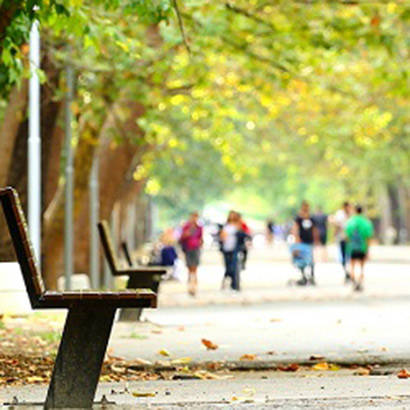
Sugar Land, Texas, is a fast-growing planned community in the Houston suburbs—a place where developers incorporated trails, along with other amenities, into subdivisions as they were built. In 2007 Sugar Land’s parks and recreation department examined that resulting network of neighborhood trails and developed a hiking/biking master plan to connect those many miles of trail infrastructure into a citywide system accessible to all residents. Sugar Land’s “Creating Connections” master plan won an American Society of Landscape Architects award in 2008—and, as parks and recreation director Jim Browne puts it, the plan’s overarching goal is to “allow people to get out of their neighborhoods and walk or ride bicycles to schools, shopping, work and parks.”
A Great American Trails grant through the Darden Foundation allowed the parks department to install benches, signage, and trash receptacles along the mile-long section of trail through Eldridge Park, an active park hosting two youth soccer leagues, central to many neighborhoods, and serving an area with relatively few trails. Those enhancements, Browne says, have enriched trail users’ experience, creating “more places where people can sit down and rest and observe the ducks on the lake or watch kids play.”
The Sugar Land LongHorn steakhouse, which opened shortly before the project began, educated trainees about the corporate vision behind the Great American Trails initiative. As a result, Browne says, LongHorn’s staff became interested not only in the trail improvements at Eldridge Park—but in opportunities to benefit other parks and recreation projects. One of those projects is a fully accessible playground the city is building with the assistance of its nonprofit fundraising arm, The Sugar Land Legacy Foundation. LongHorn servers united in setting a day to donate all tips to help build that playground—and ended up contributing about $1,000.
LongHorn’s mix of grant program and employee education represents, Browne believes, “a really responsible corporate citizenship type approach to coming into the community.”
The trail at Eldridge Park is thriving. “You can go out there on any given day, even in 100-plus heat of Houston in the summer, and there are tons of people out,” Browne comments. The enhanced trail has, in fact, gotten such heavy use that the parks department extended the hours of operation—keeping parts of it lit until well after dark.
“Ask anyone out there using the trail what they think,” The park director concludes, “and they’re going to rave about how much they appreciate it and how important it is to their daily quality of life.”
